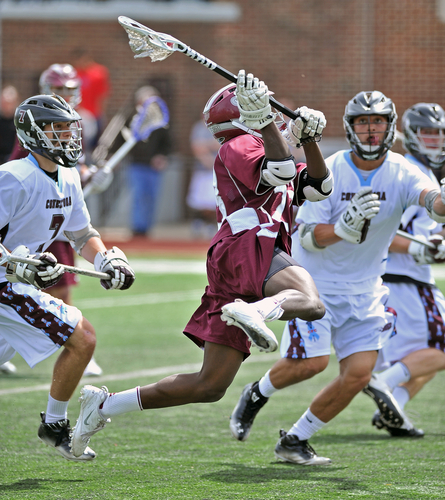Dec 2, 2016More Agile
When working with our men’s lacrosse team at the University of Maryland, I use skill-specific agility drills depending on the athletes’ positions. For our defenders, I like to use one called the “martini drill.”
Here’s how it works: Cones are placed in the shape of a martini glass and defenders backpedal through them while opening their hips to defend diagonally. Once they reach the final cone, they shuffle laterally and finish with a sprint.
I have them finish with a sprint because it simulates the quick transition opportunity that can open up after getting a turnover or recovering a loose ball. Our coaches teach the players to push the transition game from anywhere on the field, and this drill helps to reinforce that concept. It also combines many aspects of the athleticism required of our defenders and helps identify any areas in their transitioning movements that need improvement.

An important teaching point for this drill is to emphasize opening the hips when coming out of the backpedal and into the diagonal defensive movement. Players often get their feet mixed up doing this movement, so I stress initiating from the hips and driving off the back foot. During the lateral shuffle, I make sure they keep their hips low and push off their back leg to prevent “heel clicking” and maintain a good defensive position.
For our attackmen and midfielders, we try to simulate dodging as much as possible by focusing on footwork and shifting their bodyweight during agility drills. One of my favorite agility drills involves placing a cone five yards ahead of a starting point, then staggering a series of three or four cones, each two feet back and diagonal from the previous cone. The athlete sprints from the starting point to the front cone, and then, using their left foot to plant, takes two quick lateral shuffle steps towards the staggered cone. Once they take their second step, they push off their back foot and accelerate straight forward, toward the next cone, and repeat the movements until they reach the final cone.
This drill does a great job of teaching the athletes to shift their body weight and practice the footwork needed to dodge effectively. Going straight from a sprint to a move and then immediately accelerating out of it is an important sequence in any good dodge. There are many variations of this drill, including changing the lateral shuffle into a backpedal, or increasing the distance of the staggered cone to give players more time to shift their body weight.
A common problem during this drill is difficulty shifting the body weight while planting off the back leg when coming out of the second lateral shuffle step. I encourage struggling players to shift their weight from their back foot to their lead hip to help them accelerate their body weight forward and gather momentum toward their next sprint.



